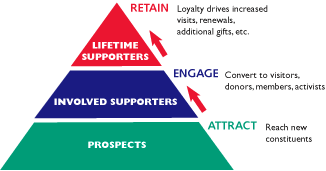|

February, 2002 - Issue 10
Succeeding Online: Moving from Transactions to Relationships
By Vinay Bhagat, Founder and CEO, Convio
Today's online nonprofit supporters have high expectations of service and communication. They want to know how organizations are using their funds so they feel good about their contributions. To be truly successful, nonprofits need to tap the Internet not only as a tool for conducting transactions, but also embrace the Internet as a relationship management tool to attract, engage and retain supporters.
Constituent Relationship Management (CRM): A framework to build relationships online
A relationship with a constituent begins by making contact with and attracting him to an organization's cause. During the course of this year, this newsletter will provide conceptual and tactical strategies for using Internet technology to: attract new, qualified prospects; convert them from prospects to active supporters; and then retain them and grow their level of support over time.
There are three key steps: attract, or reach and identify new constituents (prospects); engage, or convert prospects to supporters (donors, members, volunteers or activists); and retain those supporters for a lifetime.

A well-executed CRM plan can have a real impact on the bottom line
Thinking of the Internet as a relationship management tool can impact two principle areas in fundraising: 1) donor acquisition; and 2) donor retention.
It costs less to acquire donors online
Donor acquisition through traditional methods is expensive. Typically, leveraging direct mail to acquire donors costs between $1.15-1.50 per dollar raised. Moreover, because prospect lists are most commonly built from rented lists and the high costs of direct mail provide little scope for cultivation without solicitation, response rates are typically 1-2 percent. Additionally, traditional forms of direct mail have not proven successful at reaching younger donors.
Email, on the other hand, has a much lower unit cost for solicitation, i.e., almost zero, versus direct mail or telemarketing that costs upwards of 30 cents. Prospect lists can be built from Web site visitors and such a list represents a much more qualified pool than a rented list. Also, email communications are a much more economical method for cultivating prospects before directly soliciting them. Consequently, typical response rates for email campaigns are much higher than those for direct mail campaigns. Clearly, the Internet can provide a very cost effective donor acquisition mechanism.
It costs less to retain donors online
Managing relationships with constituents is a constant struggle for many groups. Typical donor retention rates are in the range of 50-70 percent which means that, without acquisition, a nonprofit would deplete its support base to zero in less than 10 years. Again, the high cost of paper-based communication tends to keep communications with current supporters focused on solicitation, with few resources dedicated to individual stewardship, excepting major donors. Additionally, typical mass donor communication programs don't provide for much personalization, if any. Renewal, although less costly than acquisition, is still expensive. The rule of thumb is that a fundraiser will send up to five to six mailings in an effort to renew a donor; on average, this process translates to a renewal cost of 15-25 cents per dollar raised.
Build strong relationships with supporters
Although it's important to use the Internet as a transactional tool to process gifts online, using it as a mechanism to build supporter relationships will have a far more profound impact on the long-term fundraising success of nonprofit organizations. Effective philanthropy is all about engendering a strong affinity for an organization's cause. Internet-based constituent relationship management gives nonprofit professionals a compelling new way to build higher levels of affinity for their cause.
|
|
|



